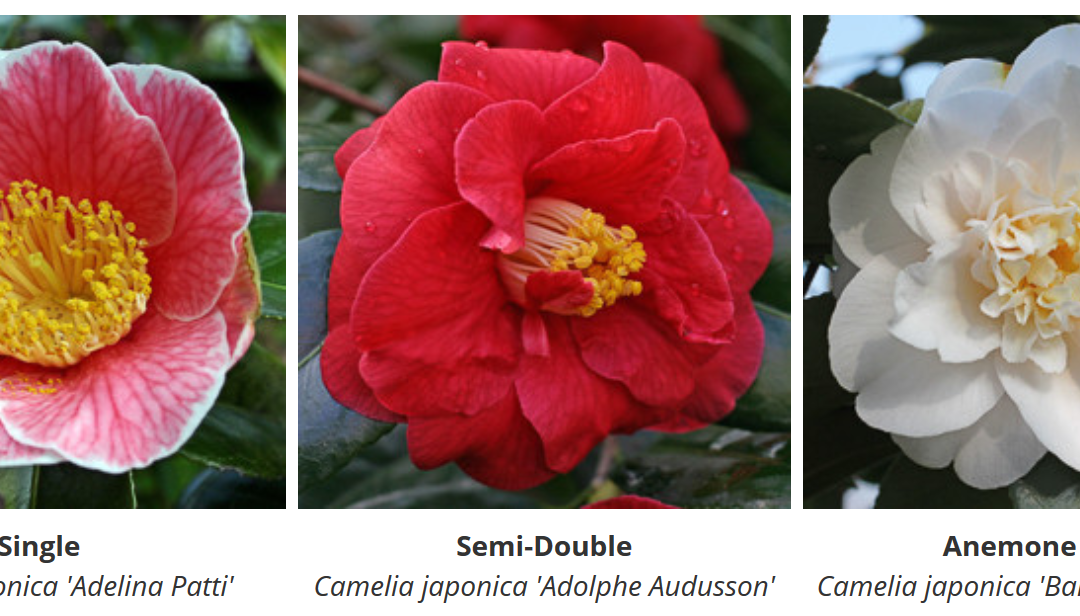
by Sheila Dunning | Jan 9, 2025
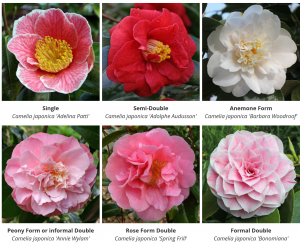 Camellias have been a part of the landscape in the Southeastern United States for over 200 years. They are native to Asia and were introduced near Charleston, South Carolina in 1786. The common name camellia refers to varieties and hybrids of Camellia japonica and to lesser known varieties of C. sasanqua and C. reticulata. The growing conditions in Northwest Florida are well suited for many camellia varieties. Camellias can serve several functions in the landscape including foundation plantings, screens, accent plants, background groupings and hedges. Maximum benefit can be achieved by mass plantings or groupings. Single plants should be focal point in beds rather than randomly placed throughout the lawn. Camellias flower in the fall and winter when their display of colorful blooms is most appreciated. During the remainder of the year their evergreen foliage, interesting shapes and textures, and relatively slow growth make camellias excellent landscape plants. Some camellia growers enjoy competing in flower shows and manipulate the flower buds to achieve larger and earlier flowers. This involves removing competing flower buds and applying gibberellic acid (a plant hormone). Individual cultivars can be selected for size and form ranging from small and irregular to large and upright. Texture and foliage color also differ among the various species and multiple varieties. Midseason flowering varieties that bloom from November through January are best suited for Florida conditions. Warm fall temperatures may prevent early varieties from flowering properly. Late-blooming selections may attempt to send out new leaves before the end of the flowering period which results in “bull
Camellias have been a part of the landscape in the Southeastern United States for over 200 years. They are native to Asia and were introduced near Charleston, South Carolina in 1786. The common name camellia refers to varieties and hybrids of Camellia japonica and to lesser known varieties of C. sasanqua and C. reticulata. The growing conditions in Northwest Florida are well suited for many camellia varieties. Camellias can serve several functions in the landscape including foundation plantings, screens, accent plants, background groupings and hedges. Maximum benefit can be achieved by mass plantings or groupings. Single plants should be focal point in beds rather than randomly placed throughout the lawn. Camellias flower in the fall and winter when their display of colorful blooms is most appreciated. During the remainder of the year their evergreen foliage, interesting shapes and textures, and relatively slow growth make camellias excellent landscape plants. Some camellia growers enjoy competing in flower shows and manipulate the flower buds to achieve larger and earlier flowers. This involves removing competing flower buds and applying gibberellic acid (a plant hormone). Individual cultivars can be selected for size and form ranging from small and irregular to large and upright. Texture and foliage color also differ among the various species and multiple varieties. Midseason flowering varieties that bloom from November through January are best suited for Florida conditions. Warm fall temperatures may prevent early varieties from flowering properly. Late-blooming selections may attempt to send out new leaves before the end of the flowering period which results in “bull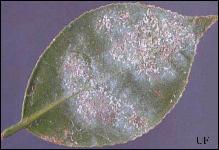 noses”. Bullnosing is characterized by poor quality flowers which do not open fully and may even drop while still tight buds. Extended dry periods while in the bud stage can make the condition more likely. While flowering, camellias need 1 inch of water applied each week. Camellias perform best in partially shaded locations which are enhanced by good drainage and air movement. Fertile, acidic soils high in organic matter are preferred. The soil must be well drained because camellias will not grow in wet areas. Do not plant them in areas with a high water table and/or hard pan. This will result in a shallow root system which is more susceptible to injury during dry periods. Camellias should be installed where cold air can move in and out freely, but the area should be protected from strong northwest winds. Plantings under established trees or in areas that have structures to block the wind are usually injured less by cold temperatures. These conditions enable the plants to gradually thaw or warm in the morning before being exposed to direct sunlight. Dense shade may result in sparse foliage and poor flowering. Camellias exposed to full sun may appear yellow-green, but may yield more flowers. Either situation is stressful to the plants and can lead to pest problems. Tea scale is the most common insect on camellias. Scales generally feed on the underside of leaves and may not be noticed until large populations have developed. Symptoms include very small elongated white and/or brown raised “flakes” on the underside of leaves that turn yellowish in color.
noses”. Bullnosing is characterized by poor quality flowers which do not open fully and may even drop while still tight buds. Extended dry periods while in the bud stage can make the condition more likely. While flowering, camellias need 1 inch of water applied each week. Camellias perform best in partially shaded locations which are enhanced by good drainage and air movement. Fertile, acidic soils high in organic matter are preferred. The soil must be well drained because camellias will not grow in wet areas. Do not plant them in areas with a high water table and/or hard pan. This will result in a shallow root system which is more susceptible to injury during dry periods. Camellias should be installed where cold air can move in and out freely, but the area should be protected from strong northwest winds. Plantings under established trees or in areas that have structures to block the wind are usually injured less by cold temperatures. These conditions enable the plants to gradually thaw or warm in the morning before being exposed to direct sunlight. Dense shade may result in sparse foliage and poor flowering. Camellias exposed to full sun may appear yellow-green, but may yield more flowers. Either situation is stressful to the plants and can lead to pest problems. Tea scale is the most common insect on camellias. Scales generally feed on the underside of leaves and may not be noticed until large populations have developed. Symptoms include very small elongated white and/or brown raised “flakes” on the underside of leaves that turn yellowish in color.
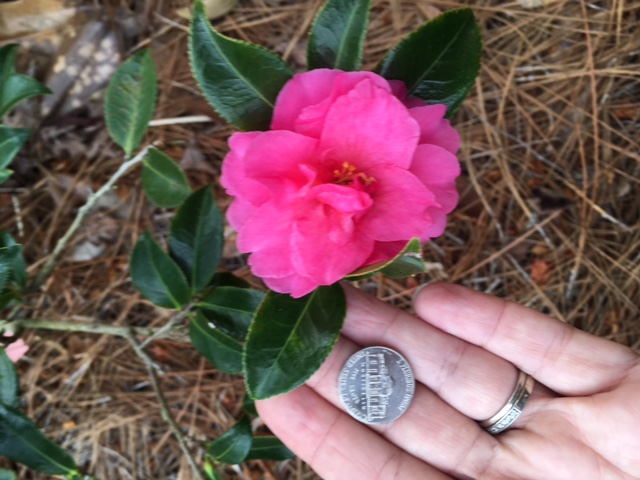
by Julie McConnell | Oct 31, 2024
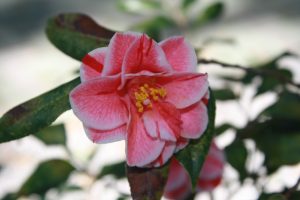 A recent visit to the Dothan Area Botanical Garden (DABG) reminded me that although many of our summer flowers are winding down, we have a great garden show coming this winter when the southern classic camellias start to show their stuff. DABG has a large collection of camellias that will start blooming in the coming months. Here is a little background on the two most common types of camellias grown in our area.
A recent visit to the Dothan Area Botanical Garden (DABG) reminded me that although many of our summer flowers are winding down, we have a great garden show coming this winter when the southern classic camellias start to show their stuff. DABG has a large collection of camellias that will start blooming in the coming months. Here is a little background on the two most common types of camellias grown in our area.
Camellia japonica
Also known as Japanese Camellia, C. japonica thrive in partial sun to full shade. Direct morning sun with some shelter from the sun in the hottest part of the day is a good compromise. Too much shade can reduce flowering, so aim for at least partial sun.
Most Japanese Camellias bloom from January to March, but some may start earlier in the season. Flower shapes include single, semi-double, anemone, peony, and formal double. Flower colors are white, pink, red, and sometimes a combination of multiple colors! Camellia japonica mature at 10-15’ tall and wide but may get as big as 25 feet. This makes them ideal to create privacy in the garden or have the lower limbs trimmed into a tree-form.
Camellia sasanqua
Sasanqua camellias also prefer part sun but can also thrive in full sun once established. Leaves and flowers are typically smaller than C. japonica which is an easy way to differentiate. Although most have upright habits and can grow 10-15’ tall as well, there are a few cultivars such as ‘Shishi Gashira’, ‘Bonanza’, and ‘Mine-no-yuki’ that have more horizontal branching making them good options for foundation plantings. Sasanqua camellia are usually in full bloom in the fall, but may bloom as late as January. Flower shapes are similar to C. japonicas, but many varieties have more open flowers with exposed stamens that are beneficial to pollinators.
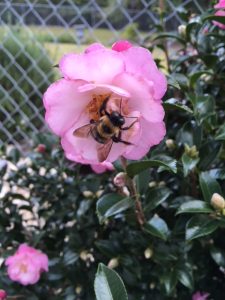
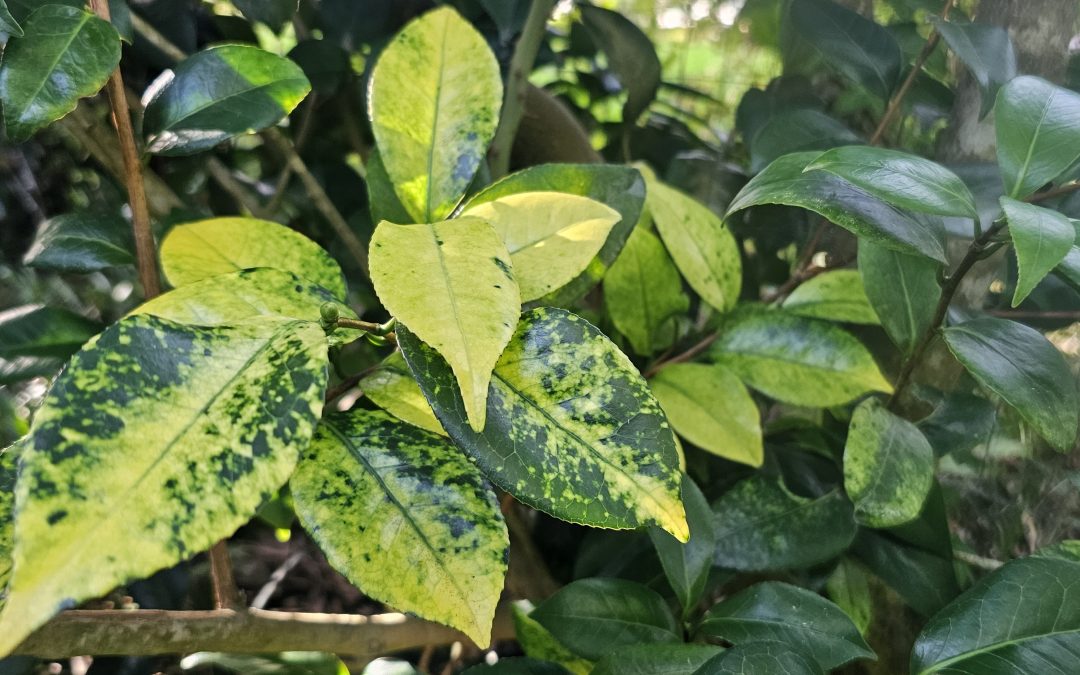
by Evan Anderson | Jun 27, 2024
An interesting phenomenon turned up in my camellia this spring. What has, for years, been a perfectly normal bush – growing its glossy, dark green leaves year ‘round and its showy flowers in the fall – suddenly changed. Its leaves started becoming variegated!
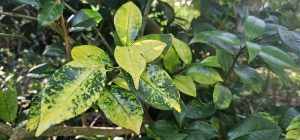
Symptoms of Camellia Yellow Leaf Mottle Virus.
Variegation refers to different colored areas of plant tissue. Most commonly, a plant will have stripes or patches of white leaf tissue along with the normal green. Sometimes, colors can vary or the placement can include stems or fruit. Many cultivated varieties of ornamental plants are selected for these interesting patterns, and sometimes food crops as well. A novel, attractive pattern can make for a very profitable plant. In the 1630s, the price of variegated tulips skyrocketed for several years in the Netherlands. During this period of ‘tulip mania’, a single tulip bulb could potentially sell for ten times the annual income of a skilled artisan. Imagine paying $200,000 for one flower!
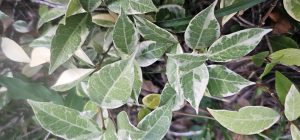
A variegated variety of star jasmine, propagated for its coloration.
Some variegations are caused by genetic mutations. Plants that are chimeras have cells with different genetic makeups. These varieties must be propagated by cutting or grafting to preserve both sets of genes. Even if successfully propagated, sometimes individual leaves or branches of these plants might lose one color or the other. A leaf that is completely white won’t thrive; it contains no chlorophyll, which gathers energy from sunlight. A leaf that becomes completely green may outcompete the rest of the variegated plant, leading to a loss of variegation over time.
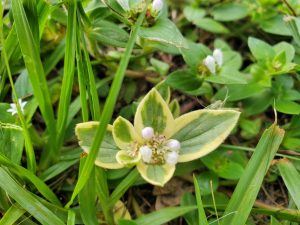
A randomly occurring genetic mutation in Florida pusley, a common weed of lawns.
Other variegations, such as those Dutch tulips and my camellia, are caused by viruses. Most are not desirable, as they decrease the health of the plant even if they don’t kill it outright. Others will quickly lead to decline and death. A mosaic virus, for example, might make your tomato leaves look interesting, but it will eventually kill the plant. In the case of a camellia, ‘camellia yellow leaf mottle virus’ is usually transmitted during the propagation or grafting process, whether intentionally or not. Camellias affected by this virus are usually not harmed, though a lack of chlorophyll in leaves leads to less energy for the plant to use in growth and producing flowers. Still, sometimes the tradeoff for fancy foliage is worth it!
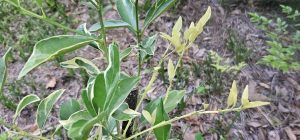
Some branches on variegated plants may turn completely white (or green).
My camellia must have received a bug bite that transmitted the virus, as I haven’t done any grafting on it. I’ve noticed a few others nearby with similar symptoms. If you see this starting on your plant, you may be able to prune out the affected area before it spreads. Make sure to sanitize pruning equipment with alcohol between cuts, and dispose of infected material if you do remove it. For other unwanted viruses, the solution may be a bit more extreme. If you cannot prevent infection in the first place through sanitation and insect control, disposal of the entire plant is often the only option that will keep the virus from spreading to other nearby plants. For any plant disease or pest issue, scout regularly and address the issue before it becomes too big. Consult your local Extension office for information or check out our EDIS publications on specific topics at https://edis.ifas.ufl.edu/.
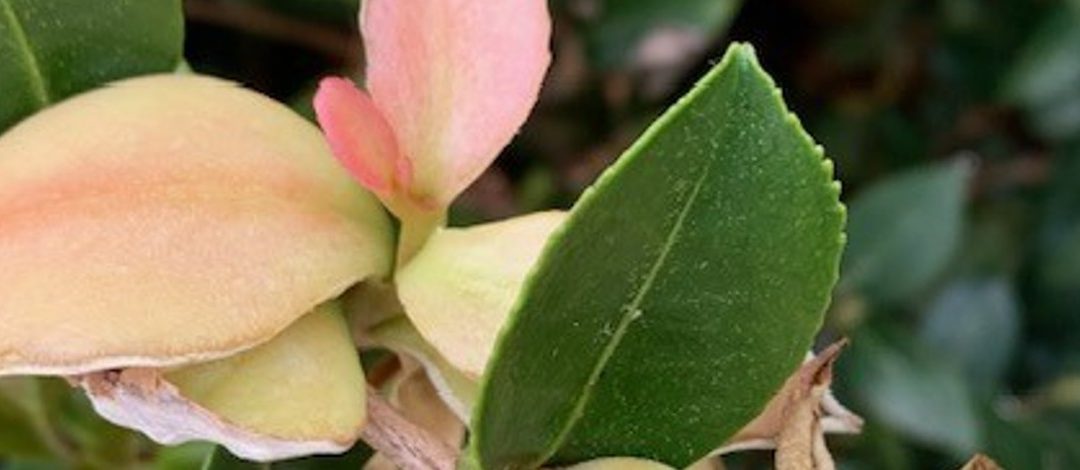
by Larry Williams | May 2, 2024
Q. Some of the leaves on my azalea and/or camellia are swollen and light green. What caused this?
A. This is caused by a fungus that has been relatively common this spring.
The fungus Exobasidium vaccinii causes leaves and flowers to become swollen or thickened, curled and waxy in appearance. This fungus causes leaves, and in some cases flower petals, to enlarge abnormally and is commonly referred to as azalea or camellia leaf and flower gall.
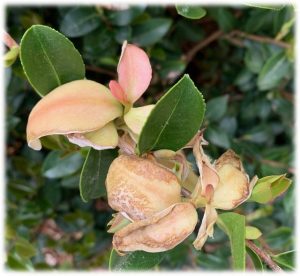
Exobasidium leaf gall on camellia. Credit: Larry Williams
Symptoms vary somewhat based on the host plant. In addition to azalea and sasanqua camellia, it can occur on blueberry, as well. Infected blueberry leaves turn an unusual bright red in spring with almost no swelling of tissue. With azaleas and camellias, leaves become large and distorted and eventually a white powder covers the galls. The white growth consists of spores, which is how the fungus reproduces. Galls ultimately turn brown and harden. Not every leaf will be infected. It’s more common for the plant’s lower leaves to be the most heavily infected but under humid conditions and in shaded locations galls may form on leaves throughout the plant canopy.
The disease relies on airborne spores produced in the whitish mold on the surface of galls in late spring to early summer to reproduce. The galls then form the following spring. It’s important to remove and dispose of infected leaves before they turn white with spores.
Once you see evidence of infected leaves, it’s too late for chemical control. Besides, there currently is no effective or practical fungicide to control this disease in the home landscape. But you can reduce the amount of infection on your plants the following year by pruning infected leaves and throwing them away before spores are produced. After removing infected leaves with galls, never leave them on the ground around the plants.
It’s best to bury, burn or place the infected leaves in a plastic bag and throw them away. This disease is more severe during a cool, wet spring. It’s advisable to not add to the problem by artificially providing the “wet weather” the spores need by frequently using an overhead sprinkler and keeping the foliage wet in the spring during disease development. This is exactly what this and many other plant diseases need – wet conditions. Yet another reason to water during early morning and on an as needed basis, versus allowing an irrigation system to frequently run when there is already adequate moisture from rain.
In the home landscape, the fungus does not cause any long-term problems for the plant. It just makes the plant’s leaves look ugly. The infected leaves will usually fall prematurely.
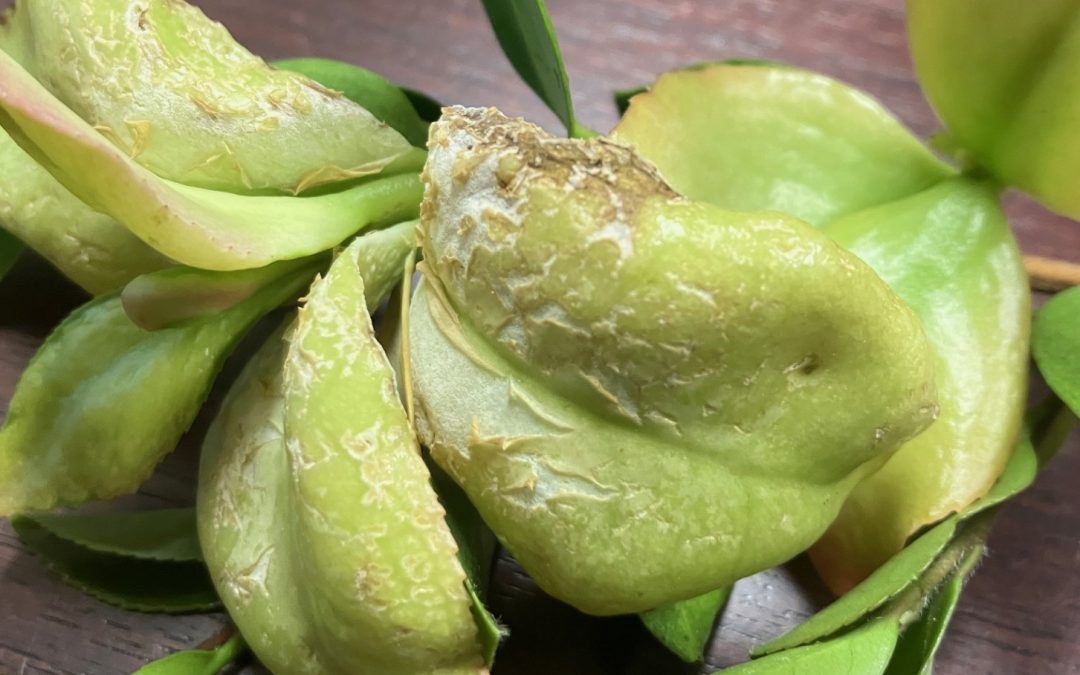
by Sheila Dunning | Apr 25, 2024
Extended spring weather with cool nights and frequent rain can be enjoyable for humans, but does strange things to plants, especially if dormant fungi are hanging around. Exobasidium vaccinii is a fungus that is believed to overwinter as spores attached to bark and bud scales. It can cause infection with the opening of buds in spring, creating odd shaped leaves and flowers that are referred to as galls. Infection is dependent on high humidity and moisture during bud break. Gall growth is due to plant cell division resulting from the stimulus of hyphal growth within host tissue. When galls are still soft, the fungus grows between epidermal cells, breaks the cuticle, and sporulates giving the gall a white cast. Either all or part of a leaf may become thickened, fleshy, and covered with a white bloom of spores. At first, diseased leaves are succulent and white, but they later shrink into hard, brown, gall-like bodies. Galls are composed of fungus-infected plant tissue. Older leaves are resistant to infection. Exobasidium vaccinii is most common in azaleas and camellias.
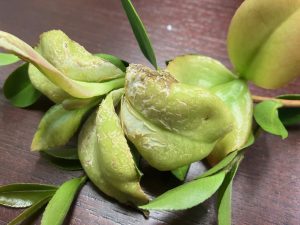
Photo by Sheila Dunning
But, other Exobasidium species are floating out there, and with just the right conditions they can deform other plants. That’s what caused this odd formation on one flower of a gardenia plant. In this case, the spores fused the sepals to the petals of the flower.
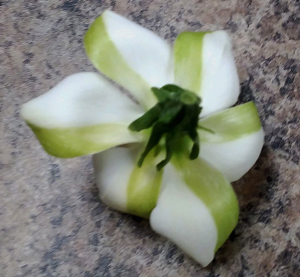
Photo by Margaret Stewart
While chemical controls are available, they would need to begin before symptoms appear and continue until the gall dried completely. It may be an option for the fastidious weather watcher with a good working knowledge of this disease. But, for the rest of the population, removing and destroying galls before they turn white is the best management practice to avoid having spores form and hang around until next spring. Proper pruning of the plants to improve air circulation will also reduce the chances of favorable conditions, should there be an extended cool, wet season next year.

 Camellias have been a part of the landscape in the Southeastern United States for over 200 years. They are native to Asia and were introduced near Charleston, South Carolina in 1786. The common name camellia refers to varieties and hybrids of Camellia japonica and to lesser known varieties of C. sasanqua and C. reticulata. The growing conditions in Northwest Florida are well suited for many camellia varieties. Camellias can serve several functions in the landscape including foundation plantings, screens, accent plants, background groupings and hedges. Maximum benefit can be achieved by mass plantings or groupings. Single plants should be focal point in beds rather than randomly placed throughout the lawn. Camellias flower in the fall and winter when their display of colorful blooms is most appreciated. During the remainder of the year their evergreen foliage, interesting shapes and textures, and relatively slow growth make camellias excellent landscape plants. Some camellia growers enjoy competing in flower shows and manipulate the flower buds to achieve larger and earlier flowers. This involves removing competing flower buds and applying gibberellic acid (a plant hormone). Individual cultivars can be selected for size and form ranging from small and irregular to large and upright. Texture and foliage color also differ among the various species and multiple varieties. Midseason flowering varieties that bloom from November through January are best suited for Florida conditions. Warm fall temperatures may prevent early varieties from flowering properly. Late-blooming selections may attempt to send out new leaves before the end of the flowering period which results in “bull
Camellias have been a part of the landscape in the Southeastern United States for over 200 years. They are native to Asia and were introduced near Charleston, South Carolina in 1786. The common name camellia refers to varieties and hybrids of Camellia japonica and to lesser known varieties of C. sasanqua and C. reticulata. The growing conditions in Northwest Florida are well suited for many camellia varieties. Camellias can serve several functions in the landscape including foundation plantings, screens, accent plants, background groupings and hedges. Maximum benefit can be achieved by mass plantings or groupings. Single plants should be focal point in beds rather than randomly placed throughout the lawn. Camellias flower in the fall and winter when their display of colorful blooms is most appreciated. During the remainder of the year their evergreen foliage, interesting shapes and textures, and relatively slow growth make camellias excellent landscape plants. Some camellia growers enjoy competing in flower shows and manipulate the flower buds to achieve larger and earlier flowers. This involves removing competing flower buds and applying gibberellic acid (a plant hormone). Individual cultivars can be selected for size and form ranging from small and irregular to large and upright. Texture and foliage color also differ among the various species and multiple varieties. Midseason flowering varieties that bloom from November through January are best suited for Florida conditions. Warm fall temperatures may prevent early varieties from flowering properly. Late-blooming selections may attempt to send out new leaves before the end of the flowering period which results in “bull noses”. Bullnosing is characterized by poor quality flowers which do not open fully and may even drop while still tight buds. Extended dry periods while in the bud stage can make the condition more likely. While flowering, camellias need 1 inch of water applied each week. Camellias perform best in partially shaded locations which are enhanced by good drainage and air movement. Fertile, acidic soils high in organic matter are preferred. The soil must be well drained because camellias will not grow in wet areas. Do not plant them in areas with a high water table and/or hard pan. This will result in a shallow root system which is more susceptible to injury during dry periods. Camellias should be installed where cold air can move in and out freely, but the area should be protected from strong northwest winds. Plantings under established trees or in areas that have structures to block the wind are usually injured less by cold temperatures. These conditions enable the plants to gradually thaw or warm in the morning before being exposed to direct sunlight. Dense shade may result in sparse foliage and poor flowering. Camellias exposed to full sun may appear yellow-green, but may yield more flowers. Either situation is stressful to the plants and can lead to pest problems. Tea scale is the most common insect on camellias. Scales generally feed on the underside of leaves and may not be noticed until large populations have developed. Symptoms include very small elongated white and/or brown raised “flakes” on the underside of leaves that turn yellowish in color.
noses”. Bullnosing is characterized by poor quality flowers which do not open fully and may even drop while still tight buds. Extended dry periods while in the bud stage can make the condition more likely. While flowering, camellias need 1 inch of water applied each week. Camellias perform best in partially shaded locations which are enhanced by good drainage and air movement. Fertile, acidic soils high in organic matter are preferred. The soil must be well drained because camellias will not grow in wet areas. Do not plant them in areas with a high water table and/or hard pan. This will result in a shallow root system which is more susceptible to injury during dry periods. Camellias should be installed where cold air can move in and out freely, but the area should be protected from strong northwest winds. Plantings under established trees or in areas that have structures to block the wind are usually injured less by cold temperatures. These conditions enable the plants to gradually thaw or warm in the morning before being exposed to direct sunlight. Dense shade may result in sparse foliage and poor flowering. Camellias exposed to full sun may appear yellow-green, but may yield more flowers. Either situation is stressful to the plants and can lead to pest problems. Tea scale is the most common insect on camellias. Scales generally feed on the underside of leaves and may not be noticed until large populations have developed. Symptoms include very small elongated white and/or brown raised “flakes” on the underside of leaves that turn yellowish in color.












